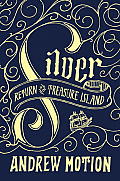What Happens to Hawkins?
Another example of British publishing’s current infatuation with latter-day sequels is Andrew Motion’s new Silver: Return to Treasure Island. Liesl Schillinger’s review in the New York Times Book Review explains the set-up:
No, Jim Hawkins uses his wealth to buy a small but solid estate in the north of England. After his mother passes away, he invests in some of the new ventures with steam engines, canals, and the like, thus growing his fortune. In time Squire Hawkins develops a reputation for being a hard bargainer, a demanding boss, and a strict landlord. A reputation that’s a bit at odds with how he chose to hire a washed-up one-legged cook who hobbled onto his estate one year.
In “Silver,” which is set some 35 years after “Treasure Island,” Motion introduces us to the son of Jim Hawkins, the original boy adventurer. Decades after making his adolescent splash, Hawkins père has washed up in a gloomy, rum-soaked middle age, running an inn on the Thames.No, no, no, no, no! Jim Hawkins is not the type to lead a dissipated life. He’s seen too much. And, frankly, he’s too greedy.
Jim Jr., serving as narrator, explains that his father had spent a decade in London, squandering his pirate booty on high living, before settling down to innkeeping and marriage with a woman who died giving birth to their child. Since then, the widower’s only joy has lain in endless retellings of his swashbuckling glory days.
No, Jim Hawkins uses his wealth to buy a small but solid estate in the north of England. After his mother passes away, he invests in some of the new ventures with steam engines, canals, and the like, thus growing his fortune. In time Squire Hawkins develops a reputation for being a hard bargainer, a demanding boss, and a strict landlord. A reputation that’s a bit at odds with how he chose to hire a washed-up one-legged cook who hobbled onto his estate one year.



No comments:
Post a Comment